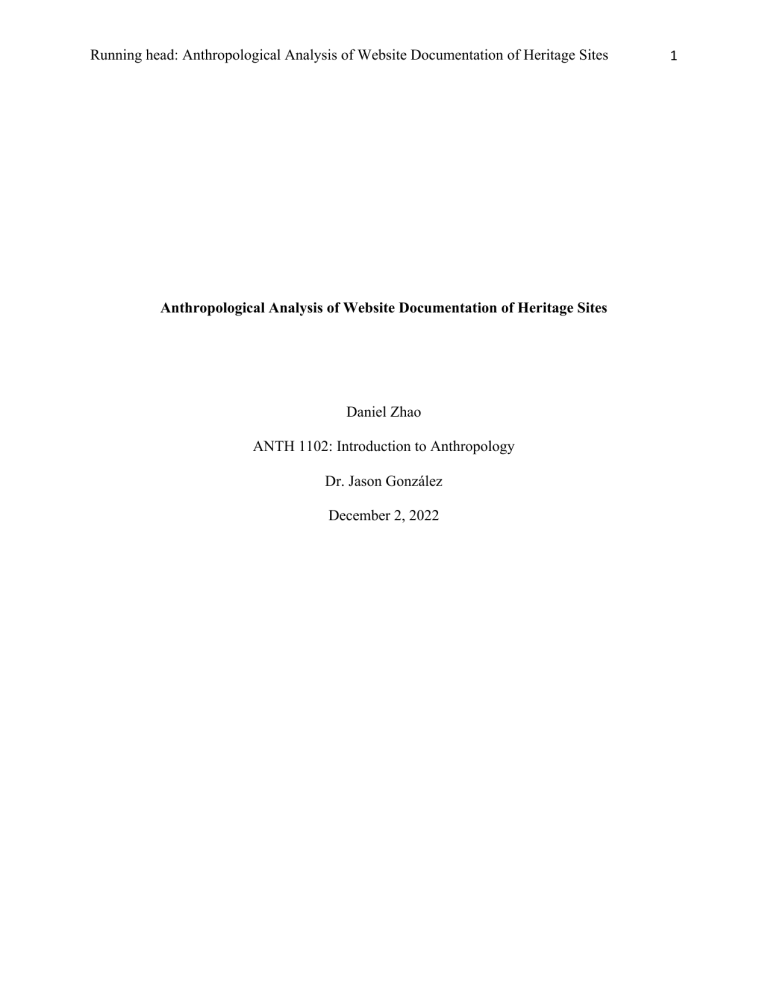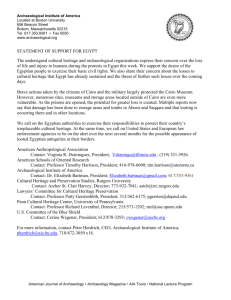
Running head: Anthropological Analysis of Website Documentation of Heritage Sites Anthropological Analysis of Website Documentation of Heritage Sites Daniel Zhao ANTH 1102: Introduction to Anthropology Dr. Jason González December 2, 2022 1 Running head: Anthropological Analysis of Website Documentation of Heritage Sites 2 Introduction: As a recent graduate from the Department of Anthropology at the University of Georgia, I have reviewed several archaeological projects from around the world to expand the Archaeology Conservancy's understanding of how these projects are organized. I am looking to expand its understanding of various archaeological projects in the United States and throughout the world. By reviewing these projects and evaluating their quality, potential for public use, threatened nature, and heritage importance, I will be able to provide valuable information that can help the Conservancy to make decisions about which projects to support and how to prioritize its resources. This is significant because the Conservancy's mission is to acquire and protect archaeological sites in the world by providing information about the quality and potential of different sites. Additionally, by conducting independent research and providing detailed analysis, I will be contributing to the field of archaeology by advancing our understanding of these important sites. I have chosen to review three projects in particular: the Catalhoyuk Excavation Project in Turkey, the Maya Archaeology Project in Belize, and the Pompeii Archaeological Park in Italy. Reviews: The Catalhoyuk Excavation Project is a long-term, multidisciplinary excavation of the Neolithic and Chalcolithic site of Catalhoyuk in central Turkey. The project's research design includes the study of the site's architecture, art, and environmental remains, as well as its social organization and economy. The project also involves community outreach and public education, including the involvement of local villagers in the excavation and the development of educational materials for schools. The site is considered threatened due to its location in a rapidly Running head: Anthropological Analysis of Website Documentation of Heritage Sites 3 developing region, and its heritage importance is significant as it provides valuable insights into early human societies. In terms of quality of work, the Çatalhöyük Excavation Project appears to be welldesigned and comprehensive, with a focus on multiple disciplinary approaches to understanding the site. The project's use of local community involvement and public education efforts also demonstrate a commitment to best practices in archaeological research. The project's educational materials and involvement of local communities has potential for the public’s use (Çatalhöyük 2022). Additionally, the project's website provides detailed information about the research and findings, making it a useful resource for those interested in learning about the site. The Çatalhöyük Excavation Project is in a rapidly developing region of central Turkey, where the expansion of urban and industrial activities poses potential threats to the site. These threats include physical damage to the site, pollution of the environment, and disruption of the natural and cultural resources. Urban development may lead to the destruction of archaeological remains or the alteration of the site's natural landscape, while industrial activities introduce pollutants that damages the site and its artifacts (Çatalhöyük 2022).. However, the project's efforts to engage local communities and raise awareness about the site's importance may help to mitigate these threats. By involving local villagers in the excavation and providing educational materials for schools, the project can build support and understanding among the local population, which can help to protect the site from the mentioned threats. Additionally, by raising awareness about the site's inmportance, the project may be able to garner support for its preservation, which can ensure that the site is preserved for future generations. The Çatalhöyük Excavation Project is important as a heritage site because it provides insights into early human societies and the development of complex social and economic systems. The site's importance is further Running head: Anthropological Analysis of Website Documentation of Heritage Sites 4 emphasized by its endangered status, making the project's work even more crucial for the preservation of this heritage. The Maya Archaeology Project is a collaborative research project focused on the ancient Maya civilization in Belize. The project's research design includes the study of Maya archaeology, art, and epigraphy, as well as the integration of Maya knowledge. The project emphasizes community outreach and public education and the involvement of Maya descendants in the research. This site is considered threatened due to its proximity to a rapidly developing region. Its heritage importance is significant as it provides valuable insights into the Maya civilization. In terms of the quality of work, the Maya Archaeology Project is well-designed and comprehensive, with a focus on interdisciplinary approaches and the integration of primary documents (Barbella 2022). The project's emphasis on community outreach and education also shows a commitment to ethical practices in archaeological research. The project has educational programs and involvement of Maya descendants demonstrates its strong potential for public engagement and accessibility. Additionally, the project's website provides detailed information about the research and findings, making it a useful resource for those interested in learning about the ancient Maya civilization. This project is situated in a rapidly developing region, which poses potential threats to the site and the preservation of Maya heritage. However, the project's efforts to involve local communities and raise awareness about the of the site may help to mitigate the mentioned threats (Barbella 2022). The Maya Archaeology Project is highly significant as it provides intangible insights into the ancient Maya civilization and its cultural traditions. The project's efforts to integrate traditional knowledge and involve Mayan natives into the research adds to its cultural preservation points. Running head: Anthropological Analysis of Website Documentation of Heritage Sites 5 Finally, the Pompeii Archaeological Park is a large archaeological site in Italy, features the remains of the ancient Roman city of Pompeii, which was destroyed by the eruption of Mount Vesuvius in 79 AD. The project includes the study of Pompeii's architecture, art, and everyday life, as well as its social, political, and economic systems (Pompeii 2022). The project also includes public education and the development of educational materials and guided tours of the site. The site is considered threatened due to it being near a seismically active region. Its heritage importance is significant as it provides insights into ancient Roman life and culture. The Pompeii Archaeological Park is also well-designed and comprehensive, with a multi-disciplinary approach to understanding the site. The project's public education efforts also demonstrate a commitment to making the site accessible and engaging for visitors, so the park is a popular tourist destination, attracting millions of visitors each year. The project's educational materials and guided tours make it a valuable resource for those interested in learning about the ancient city and its history. The Çatalhöyük Excavation Project and the Maya Archaeology Project stand out as the top two projects in terms of quality of work, potential for public use, and heritage importance. Both projects have strong research designs, involve community outreach and public education, and are situated in threatened areas with significant heritage importance. The Pompeii Archaeological Park is also a well-designed project with potential for public use and educational value, but the site is less threatened and has arguably less heritage importance than the other two projects. Overall, my analysis suggests that the Archaeology Conservancy should prioritize supporting these three projects to protect and preserve the heritage of these significant sites. Final Thoughts Running head: Anthropological Analysis of Website Documentation of Heritage Sites 6 All the projects reviewed in this report have strong research designs and focus on multidisciplinary approaches to understanding the sites. They also involve community outreach and public education, emphasizing the importance of involving local communities in the research and raising awareness about the significance of the sites. My analysis demonstrates that the archaeological research provides a comprehensive understanding of the sites and the societies that inhabited them. This understanding can help preserve and protect the sites for future generations and much needed insights into the history of human cultures. The long-term intentions of archaeological research are to continue studying the sites and to preserve their cultural heritage for future generations. Additionally, by including local communities in our research, we can also help to build support and understanding for the preservation of these sites, which is crucial for ensuring their long-term success. Works Cited: Kottak, Conrad Phillip. Cultural Anthropology: Appreciating Cultural Diversity. McGraw-Hill, 2022. Çatalhöyük Research Project. “Çatalhöyük Research Project.” Çatalhöyük Research Project, http://www.catalhoyuk.com/. “MRP Homepage.” Maya Research Program, http://www.mayaresearchprogram.org/. Barbella, Giuseppe, and Alessandro Tartaglione. “Homepage - Pompeii Sites Official Archaeological Site.” Pompeii Sites, 18 Nov. 2022, http://pompeiisites.org/en/.




